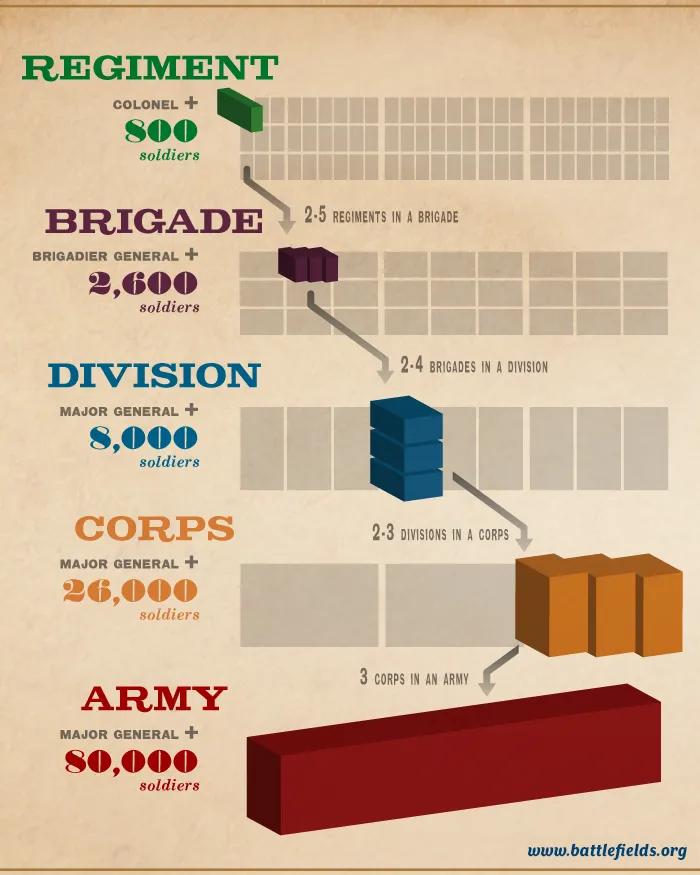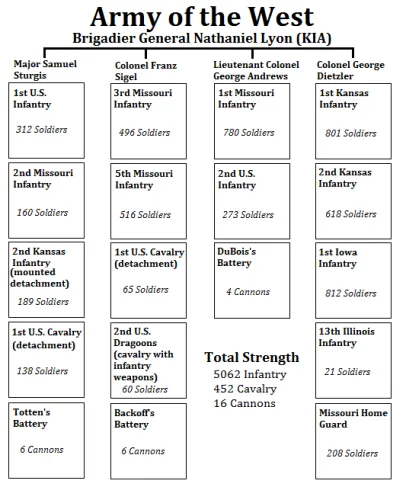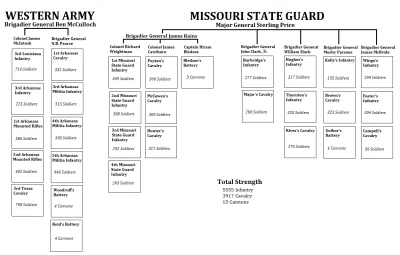
Pursuit of Lee's army; scene on the road near Emmitsburg - marching through the rain painted by Edwin Forbes.
The contending armies in the Civil War were organized with the intent of establishing smooth command and control in the warzone. The structures employed changed drastically over the course of the struggle in response to new currents in strategic thought and the demands of specific circumstances. The operational deployment of organized armies, as opposed to loosely ordered battlefield rabbles, has gone through periods of use and disuse throughout human history. The Civil War codified several elements of army structure that are still used today.

The chart above represents a typical late-war Union army structure.
The regiment was the basic maneuver unit of the Civil War. They were recruited from among the eligible citizenry of one or more nearby counties and usually consisted of 1,000 men when first organized. The attrition of disease, combat, and desertion would rapidly reduce this number. Replacements were exceedingly rare for both sides--it was more typical for an entirely new regiment to be raised instead. Regiments were usually led by colonels.
Two or more regiments would be organized into a brigade. Note that it was uncommon for the branches of the army--infantry, cavalry, and artillery--to be mixed within a brigade. A typical brigade would consist of between three and five regiments and be led by a brigadier general.
Two or more brigades would be organized into a division. Divisions tended to be slightly smaller in the Union army--usually two or three brigades. Confederate divisions could include as many as five or six brigades. Divisions were led by major generals.
Two or more divisions would be organized into a corps. A corps typically included infantry, cavalry, and artillery units, the idea being that a corps was a formation that could conduct independent operations.
Two or more corps would be organized into an army. It is commonly assumed that there was only one army per nation, but in fact both nations had multiple armies in the field. The most well-known Confederate armies are the Army of Northern Virginia, led by Robert E. Lee for most of the war, and the Army of Tennessee, which had a string of different commanders. The Union Army of the Potomac was Lee's primary opponent, while the Army of the Cumberland and Army of the Ohio operated out west, among others. At the corps and army level, leadership would usually be determined by seniority among the available major generals, or by intervention from Abraham Lincoln or Jefferson Davis.
Problems and Solutions
When the war began, neither side knew exactly which army structure would be most effective. Additionally, neither side thought the war would last very long, so there was a certain amount of lee-way granted to those who recruited units, however they were organized, and brought them to the front. Both sides explored a variety of structures throughout the war.
One of the most significant themes in the evolution of Civil War armies was the gradual division of the three branches. At the outset of hostilities, it was not uncommon to see a brigade that consisted of infantry regiments, cavalry regiments, and artillery batteries, as seen in this example from the 1861 Battle of Wilson's Creek.

Over time, leaders on both sides realized that this jumble of responsibilities led to issues on the battlefield. The effectiveness of artillery, it was determined, could be expanded by organizing them into larger and more independent units. Thus, by 1863, we begin to see unified artillery brigades in place of individual batteries attached to infantry units. No longer diluted by haphazard deployment across the battlefield according to the needs of low-level commanders, artillery could be centrally directed to maximize its firepower at key points on the line. The 150-gun bombardment that preceded Pickett's Charge at Gettysburg in 1863 would not have been organizationally possible a year before.
Similarly, cavalry began the war attached to brigades or divisions. Usually equipped with weapons of shorter range and lighter caliber than foot soldiers, cavalry could not be expected to go toe-to-toe with infantry. They still retained a huge mobility advantage, but this was rarely exploited by the commanders in charge, who did not have formal education in cavalry tactics and instead made more frequent use of horsemen as couriers or scouts. Sparked by the innovations of cavalrymen such as J.E.B. Stuart and Alfred Pleasonton, an organizational shift towards a unified cavalry force offered the potential for more damaging raids, more effective intelligence-gathering, and, later in the war, huge formations of horsemen equipped with brand-new rapid-firing weaponry that had no equal in the world at the time.

The problem of the chain of command also shaped the war. The chart above follows a pyramid structure, with authority flowing down from a single chief executive. At the beginning of the war, however, there was a greater tendency for authority on a battlefield to flow more horizontally, with more units operating autonomously, as was the case at Bull Run or Wilson's Creek. In both of those battles the Confederate forces on the field were actually divided into two small armies with neither having a legitimate claim to command the other. In both battles this friction slowed or disrupted maneuvers and cost lives. As the war continued, both sides took care to firmly establish the chain of command.
This was not always possible on a battlefield, because commanders frequently became casualties. When an officer went down, his replacement was supposed to come from the most senior of his subordinates--a brigadier general replaced by the senior colonel in his brigade, the colonel replaced by the major, and so on. Thus an officer's death or wounding would result in a grand theoretical shuffling of responsibility as every man beneath him took one step up in the chain of command. Of course, a colonel lost in a cloud of gun smoke a mile away from his brigade commander would not immediately know of his de facto promotion. Only in unusual circumstances would an officer's fall lead to a somewhat smooth transition of authority--it was far more common for the chain to break down, for the battle to be lost, and for the questions of seniority to be worked out afterwards. One division's assault at Fredericksburg collapsed after two of its brigade commanders got trapped under falling horses and could not be immediately found.
Long-term Implications
Several features of today's military structure can be tied directly to Civil War innovations.
Heavy artillery is still typically deployed by headquarters. While there are a number of weapons systems available to modern-day infantry units that weren't around during the Civil War, such as man-portable mortars, it is more common to see heavy artillery formations directed by an autonomous commander.
The maintenance of a large, unified, and well-equipped cavalry wing has proved essential to recent American wars. With the main advantage of horses--mobility-- replaced by technology such as airplanes, tanks, and helicopters, the essential effectiveness of wedding mobility with firepower has multiplied.
The Civil War led to the establishment of the first American staff school in order to train officers in the art of order transmission and execution.
One of the most significant changes in military structure was the introduction of the United States Colored Troops in 1863, the first official military integration policy. In just more than a year over 10% of the Union army was made up of black soldiers.
The long grind of the Civil War forced the development of a more rigorous, efficient military than had previously existed on the American continent.





